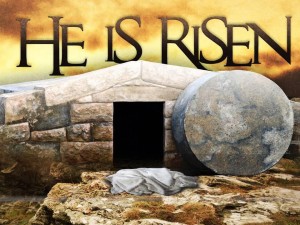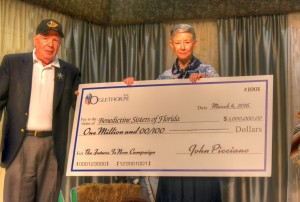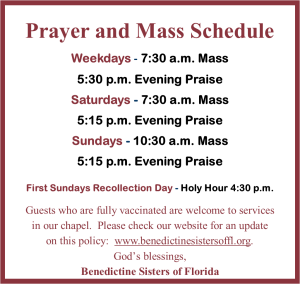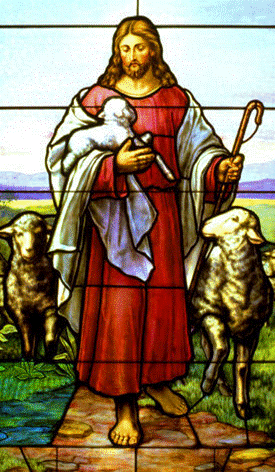
 Have any of your ever raised sheep? Or played with a lamb? Maybe you’ve seen or touched a lamb at a demo farm for children? Ok, so what we know about sheep we’ve learned from the media or in a science class. I’ll take it for granted that you are a little familiar with the metaphors of sheep and shepherds but no so much as those who listened to Jesus talking about shepherds tending their sheep. But, the image of Jesus as Good Shepherd has endured over the centuries as a primary image in our faith tradition. One of the few Christian symbols dating from the first century is that of the Good Shepherd carrying on His shoulders a lamb or a sheep, with two other sheep at his side.
Have any of your ever raised sheep? Or played with a lamb? Maybe you’ve seen or touched a lamb at a demo farm for children? Ok, so what we know about sheep we’ve learned from the media or in a science class. I’ll take it for granted that you are a little familiar with the metaphors of sheep and shepherds but no so much as those who listened to Jesus talking about shepherds tending their sheep. But, the image of Jesus as Good Shepherd has endured over the centuries as a primary image in our faith tradition. One of the few Christian symbols dating from the first century is that of the Good Shepherd carrying on His shoulders a lamb or a sheep, with two other sheep at his side.
The power to describe the relationship between Jesus and his followers doesn’t necessarily require first-hand experience with raising or tending sheep. In the earliest Christian art, the only depictions of Jesus are as the Good Shepherd. And that image of Jesus persisted until about 500 AD. By that time eighty-eight frescoes of the Good Shepherd depicted on the ceilings of the Roman catacombs because artists had run out of space of the walls of the churches of Rome. The image speaks to us about the protection, intimacy, security, and care of shepherds for their sheep.
If we don’t know anything about the customs of shepherds and the unique relationship between the good shepherd and the sheep, then much of what the Psalms, namely Psalm 23, have to say will simply passes us by.
It’s an image of Jesus that’s popular with many people. In some we see Jesus holding a lamb around his neck, over his shoulders, holding the two front legs of the sheep in one hand and the two rear legs in the other. These images appeal to us because of the tenderness of Jesus, his care and compassion for the lamb. Our minds naturally begin to wander and we realize it holds personal meaning for us. We are that lamb who is being carried by Jesus. It’s reassuring for us, in the dark days of our lives, that although we may feel empty and alone, we are never abandoned. This is portrayed very beautifully in the poem Footprints which you may recall.
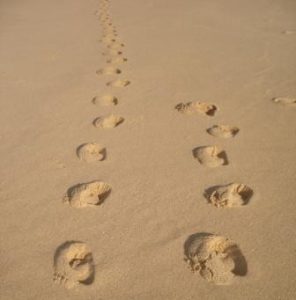 In each scene (of my life) I noticed footprints in the sand.
In each scene (of my life) I noticed footprints in the sand.
Sometimes there were two sets of footprints, others times there was one set of footprints.
This bothered me because I noticed that during the low periods of my life,
When I was suffering from anguish, sorrow or defeat, I could see only one set of footprints.
So I said to the Lord, “You promised me, Lord, that if I followed you, You would walk with me always.
But I Have noticed that during the most trying periods of my life
There has only been one set of footprints in the sand.
“Why, when I needed you most, have you not been there for me?”
The Lord replied, “The years when you have seen only one set of footprints,
My child, is when I carried you.”
The image of the Good Shepherd is symbolized in a beautiful way by the Pallium which the pope and archbishops wear over their shoulders while celebrating Mass. The Pallium is made from lamb’s wool from sheep raised by the Trappist monks on the outskirts of Rome. When mature, the sheep are taken to the Pope for a blessing and then cared for by Benedictine Nuns at St. Cecelia’s (where Benedict lives while he was going to school in Rome) until they are sheared on Holy Thursday. The lamb’s wool is meant to represent the lost, sick or weak sheep in the desert which the shepherd finds and places on his shoulders and carries to the waters of life.
One of the amazing things about shepherds and their sheep is how the shepherd moves them from place to place – and how the sheep know and trust the voice of their shepherd. A similar phenomenon is observed when expectant parents speak to their babe in utero, reciting nursery rhymes, reading stories aloud – even adult literature or the newspaper – when after birth the infant perks up at the sound of that voice, the cadence of the words being read, indicating, “I heard that before.”
Some people think sheep are rather dumb – but really they are not. Perhaps, it is cattle ranchers who are responsible for spreading that ugly rumor, because sheep do not behave like cows. Cows are herded from the rear by hooting cowhands with cracking whips, but that will not work with sheep. If you come up behind a flock of sheep making loud noises and all they will do is run around behind you, because they prefer to be led. You push cows, but you lead sheep, and they will not go anywhere that someone else does not go first namely their shepherd who goes ahead of them to show them that everything is all right.
At night the shepherd can walk right through a sleeping flock without disturbing a single one of them, while a stranger cannot step foot in the fold without causing pandemonium. And when several shepherds and their sheep are at a watering hole and it is time to leave all the shepherds have to do is call and their flock separate themselves out – and follow their shepherd away.
This is what we need to do when confronted with a cacophony chorus of conflicting opinions … but we can only do this if, as Pope Francis reminds us, “it is essential in order to cope with complexity and change, that we have developed the ability to withdraw for quiet reflection. Only then will we truly know the voice of our shepherd, heed His voice and follow wherever God calls.


